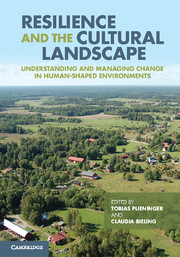 Resilience and the Cultural Landscape
Resilience and the Cultural Landscape Published online by Cambridge University Press: 05 November 2012
Introduction
The plantation sugar-cane landscape has been the most distinctive cultural landscape in a number of Caribbean islands since colonisation, surviving in its basic form for over 500 years. We regard it as the physical manifestation of a well-defined social–ecological system that has demonstrated remarkable resilience – defined as ‘the capacity of a system to experience shocks while retaining essentially the same function, structure, feedback and, therefore, identity’ (Walker et al., 2006). While the landscape has survived in its general form for centuries, the plantation system it reflects has undergone dynamic changes in space and time that have facilitated resilience, changes that have included a transition from the system’s most notorious feature – slavery – to the current period of rationalisation and decline. This chapter illustrates how one can understand the sugar-cane landscape through the lens of resilience thinking – and through reference to the heuristics of adaptive cycles and panarchy, in particular. It also offers interpretations of different forms of sugar-cane landscape as cultural landscapes, and illustrates how this perspective can be combined with resilience thinking to enrich our understanding of landscape character and change.
Caribbean sugar-cane cultural landscape
Sugar-cane has been grown commercially in the Caribbean islands (Figure 10.1) since the early sixteenth century. The plantation is both an agricultural and an industrial site, and buildings important to production (e.g. mills, housing for workers) and populations supplying the labour form important components of the cultural landscape. At one time, most inhabited islands of the Caribbean produced cane, but the dates when cultivation was first introduced and then terminated, the technologies used in the agricultural/industrial process, the inclusion of non-sugar land uses in the landscape and the populations forming the labour supply have varied significantly from island to island. Even within individual islands, sugar-cane landscapes have reflected local variation. Large plantations, owned by individuals, companies or governments, have dominated the areas of sugar production, tending to occupy the land with the highest quality, but small properties, sometimes using traditional techniques on marginal lands, have coexisted. Thus, while the distinctive light-green sugar-cane component of the landscape has persisted for centuries, its dominant visual impact has tended to obscure important space/time variations.
To save this book to your Kindle, first ensure [email protected] is added to your Approved Personal Document E-mail List under your Personal Document Settings on the Manage Your Content and Devices page of your Amazon account. Then enter the ‘name’ part of your Kindle email address below. Find out more about saving to your Kindle.
Note you can select to save to either the @free.kindle.com or @kindle.com variations. ‘@free.kindle.com’ emails are free but can only be saved to your device when it is connected to wi-fi. ‘@kindle.com’ emails can be delivered even when you are not connected to wi-fi, but note that service fees apply.
Find out more about the Kindle Personal Document Service.
To save content items to your account, please confirm that you agree to abide by our usage policies. If this is the first time you use this feature, you will be asked to authorise Cambridge Core to connect with your account. Find out more about saving content to Dropbox.
To save content items to your account, please confirm that you agree to abide by our usage policies. If this is the first time you use this feature, you will be asked to authorise Cambridge Core to connect with your account. Find out more about saving content to Google Drive.